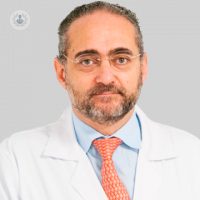Trigeminal neuralgia: what it is
Written by:Trigeminal neuralgia It is a highly disabling disease consisting of episodes of very intense pain in precise areas of the face, usually triggered by a stimulus (eating, speaking, cold), of uncertain cause with an estimated frequency of appearance of one every 15,000 people a year , although possibly this incidence is greater due to diagnostic errors. A trigeminal neuralgia is also called " suicidal disease ", due to the large number of patients who committed suicide because of the inability to bear the pain before they appeared effective means of treatment, such as current.
Its symptoms are intense paroxysmal pain or sudden , always affecting the same area of the face, which are defined as "electric shock" highly invalidating, which are caused by things as common as talking or eating and forcing whoever suffers not to speak, not eat or show a deadpan face in fear that the slightest movement of the face will cause a painful discharge. These painful crises, in their typical form, affect one side of the face and the same facial area, of variable duration , but they can be repeated hundreds of times in a day. There may be spontaneous remissions that can last for months or even years.
Treatment of trigeminal neuralgia
Its initial treatment is medical, considering a good response to carbamazepine an almost diagnostic criterion of typical neuralgia. Unfortunately, intolerances to carbamazepine or a progression of pain can occur despite a good initial response, which is quite common, starting with drug mixtures ( pregabalin , gabapentin , other antiepileptic drugs , antidepressants ) and even opiates.. At this point you can talk about failure of medical treatment, and should consider a surgical treatment .
This surgical treatment can be of three types : percutaneous approach to the Gasser ganglion (trigeminal nerve ganglion) to injure the fibers that transmit pain through alcohol, heat or pressure; Microvascular trigeminal decompression , by opening the skull and microsurgery; or radiosurgical treatment , which consists of radiation with very high doses of the apparent origin of the nerve at its entrance to the brainstem. Each one has advantages and disadvantages , but in summary: microvascular decompression is the one with the greatest chance of success, but it is the one with the most complications and the most serious ones.. The least invasive are radiosurgery and the percutaneous approach to the Gasser ganglion, but the latter only causes temporary relief, so that the repetition of sessions increases the risk of complications, and radiosurgery is not free of risks. In general, patients who do not have surgical contraindications are advised, regardless of their age, microvascular decompression as the most definitive method, although each case must be individualized by someone who knows all the techniques.
The treatment of atypical and secondary neuralgia (for example, multiple sclerosis) is more controversial and requires an even more individualized approach .



